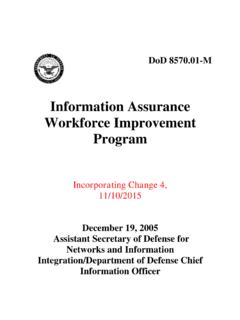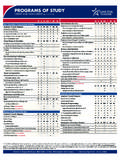Transcription of Distributed Common Ground System – Army (DCGS-A) …
1 Director, Operational Test and Evaluation Distributed Common Ground System Army (DCGS-A) Increment 1 Release 2 Follow-on Operational Test and Evaluation (FOT&E) Report January 2016 This report on the Distributed Common Ground System Army (DCGS-A) fulfills the provisions of Title 10, United States Code, Section 2399. It assesses the adequacy of testing and the operational effectiveness, operational suitability, and cybersecurity posture of the DCGS-A. J. Michael Gilmore Director This page intentionally left blank. i Executive Summary This report provides the Director, Operational Test and Evaluation s (DOT&E s) operational evaluation of the Distributed Common Ground System Army (DCGS-A) Increment 1, Release 2.
2 The evaluation is based on the Follow-on Operational Test and Evaluation (FOT&E) conducted by the Army Test and Evaluation Command (ATEC) from May 2 14, 2015, during the Army s Network Integration Event (NIE) , at Fort Bliss, Texas. The FOT&E included cybersecurity test events conducted by ATEC, the Army s Threat System Management Office (TSMO), and the National Security Agency (NSA) during March through June 2015. Additional data came from a data synchronization test at the DCGS-A Ground Station Integration Facility (GSIF) at Aberdeen Proving Ground , Maryland, in September 2015. A team composed of ATEC, DOT&E, and Program Management Office personnel designed and conducted the GSIF event.
3 The FOT&E was adequate to evaluate the operational effectiveness, suitability, and survivability of DCGS-A, but inadequate to quantify performance details of DCGS-A functionality. ATEC conducted the test events in accordance with the DOT&E-approved test plan, but did not conduct the data collection, reduction, and analysis as described in the test plan. ATEC s test database did not provide sufficient data for a quantitative assessment of intelligence fusion, targeting, and data synchronization functions. The GSIF event added sufficient additional data to supplement the evaluation of data synchronization; DOT&E used these data to identify the cause of data synchronization issues discovered during the FOT&E.
4 The FOT&E included both Combined Arms Maneuver (CAM) and Wide Area Security (WAS) scenarios. The event mixed live and simulated units and replicated corps-level enemy regular forces and insurgents, which fought friendly division, brigade, and battalion-level units. To evaluate the System s ability to help users find, process, exploit, and disseminate intelligence information, ATEC inserted 10 vignettes 5 for CAM and 5 for WAS into the test scenario. These vignettes were operationally realistic story lines such as finding and destroying facilities that manufacture improvised explosive devices (IEDs), and finding and targeting enemy troop movements.
5 To support the vignettes, the test team injected intelligence data elements (such as intercepted communications, situation reports, satellite pictures, and full motion videos), that corresponded to the vignettes into a database containing terabytes of other information, including actual intelligence from combat This large, realistic database comes from the Training Brain Operations Center (TBOC). The Army uses the TBOC database for intelligence analyst training. A key objective of the FOT&E was to evaluate the unit s ability to use DCGS-A to discover the injected data elements, and use the data elements to reach accurate conclusions regarding the enemy actions.
6 DCGS-A is operationally effective. The test unit successfully received, processed, exploited, and disseminated intelligence data with DCGS-A. The unit provided actionable 1 The Training Brain Operating Center (TBOC) derives intelligence data from combat theaters. The test team modified names and other details of the TBOC data to fit with the NIE scenario. ii intelligence to commanders, enabling them to make timely decisions. The test brigade commander stated that DCGS-A helped produce useful intelligence products in hours instead of days or weeks. Test data from the vignettes and test logs captured sufficient evidence that the unit was able to rapidly find relevant information and draw accurate conclusions about the enemy s actions.
7 The test unit did not always accurately attribute the troop and equipment to the correct enemy unit, but did accurately capture the movement of enemy troops and equipment. The Army resolved the System shortfalls which were reported in the DOT&E s November 1, 2012, memorandum and classified Initial Operational Test and Evaluation (IOT&E) report: 2,3 Database discrepancies: The IOT&E version of DCGS-A had a different database structure and protocols for the Top Secret/Sensitive Compartmented Information (TS/SCI) and Secret enclaves. DCGS-A Release 2 implemented the same Tactical Entity Database (TED) for both enclaves, markedly improving System performance.
8 TS/SCI enclave: During the IOT&E, DCGS-A intelligence fusion tools were available to users only in the TS/SCI enclave. This meant all Secret information had to be sent through a cross-domain solution to the TS/SCI enclave to exploit, and the product then had to be sent back to the Secret enclave, again through the cross-domain solution, to share with other command and control systems. This workflow made the unit s work process unnecessarily time consuming. DCGS-A Release 2 resolved this shortfall by making intelligence fusion tools available in both enclaves. cybersecurity : The IOT&E revealed many cybersecurity vulnerabilities. The Army mitigated many of the vulnerabilities with DCGS-A Release 1, and mitigated all major vulnerabilities with Release 2.
9 The remaining cyber security shortfalls are attributable to the Army s tactical network environment. DCGS-A is operationally suitable, provided the Army intensively trains DCGS-A users, and provides refresher training to units in garrison. DCGS-A is a complex System and the skills required to use it are perishable. The operational availability (Ao) of DCGS-A satisfied the requirements at all echelons and reliability of the System improved from IOT&E. There were no hardware failures during the FOT&E; however, software failures were still a challenge for users. The System required reboots about every 20 hours for users who had heavy workloads such as the fire support analysts and data managers in the BCT Tactical Operations Center (TOC).
10 The extensive unit-level training over three training events leading to the FOT&E gave the unit the chance to develop and train the tactics, techniques and procedures to use the System in support of 2 DOT&E memorandum to the Undersecretary of Defense for Acquisition, Technology and Logistics (USD(AT&L)), Subj: Deployment Decision for Distributed Common Ground System Army (DCGS-A) Release 1. 3 DOT&E, Distributed Common Ground System Army (DCGS-A) Software Baseline (DSB ) Initial Operational Test and Evaluation (IOT&E) report, October 2012 (SECRET). iii the mission. For users to be able to operate DCGS-A effectively, the Army needs to continue to provide such comprehensive training.














